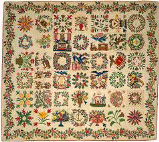Textile Society of America

Textile Society of America: Symposium Proceedings
Date of this Version
2024
Document Type
Presentation
Citation
Textile Society of America 2024 Symposium
Shifts & Strands: Rethinking the Possibilities and Potentials of Textiles, November 12-17, 2024, a virtual event
Abstract
Textiles from Cabo Verde were highly prized for trading along the West African coast, from the second half of the 16th century to the end of the 18th century. They originated from the fusion of different cultural sources making their design visually distinct from the other textiles of West Africa: slave weavers were taken to Cabo Verde by the Portuguese and with their characteristic narrow strip looms, which had to be adjusted, were made to weave textiles with North African patterns and Christian references.
From the 19th century, a marked decline in the manufacture of these historic textiles is witnessed due to the demise of the local cotton and dyes production, alongside with a lack of demand for them, particularly the ones with high-value price. Today, local weavers use the narrow strip loom to work mostly with imported yarn, including synthetic, and use other designs and approaches, such as tapestry. Recently, the project ‘Neve Insular’ in São Vicente Island attempts to grow cotton for yarn production.
The study about the structure, patterns and design of the historic pano d’obra (laborious cloth, i.e. very time-consuming and demanding cloth to weave) and pano d’obra bicho (laborious cloth with a distinct border widthwise) textiles is presented: lengthwise, both are characterized by an organized and symmetrical structure in relation to the middle of the cloth; the patterns range from simple geometrical shapes to more elaborated ones such as the eight-pointed star and others resembling animal skin; the design reflects the different cultural influences.
Included in
Africana Studies Commons, Art and Materials Conservation Commons, Art Practice Commons, Fashion Design Commons, Fiber, Textile, and Weaving Arts Commons, Fine Arts Commons, Museum Studies Commons


Comments
Published by the Textiles Society of America
Copyright 2024, the author. Used by permission